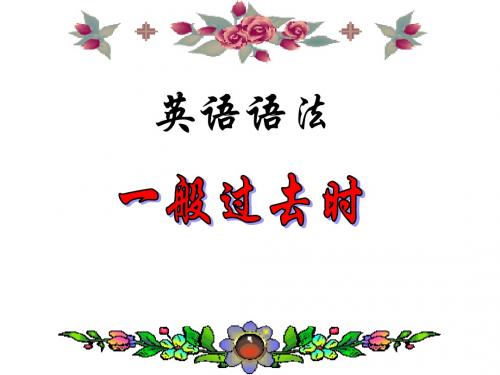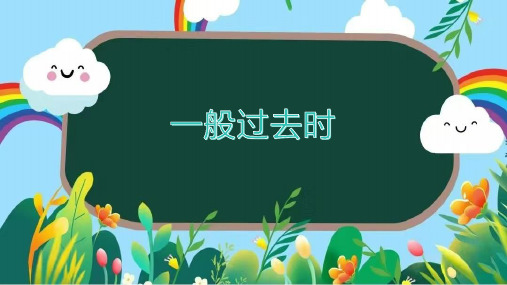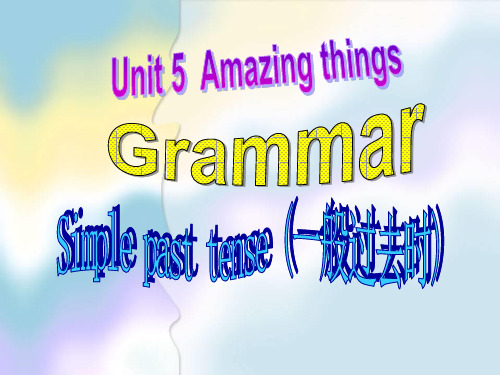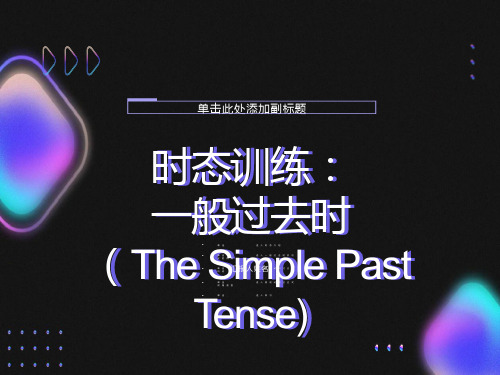一般过去时.语法讲解PPT
一般过去时.语法讲解PPT

一般过去时常用的时间状语包括过去的时间点、过去的时间段 等,而过去完成时常用的时间状语包括“已经”、“之前”等
。
05
一般过去时的练习与巩固
填空练习
总结词
填空练习是巩固一般过去时的有效方法,通过在句子中留空,让学生填写正确的动词时态,加深对一般过去时的 理解和运用。
详细描述
在填空练习中,教师可以选择一些包含一般过去时的句子,故意去掉动词时态部分,让学生根据上下文语境和时 态规则填写正确的时态。例如,“Yesterday, I ____(go) to the park with my family. We ____ (have) a great time.” 学生应该填写“went”和“had”。
表示过去的习惯或经常发生的动作
描述过去的习惯
一般过去时可以用来描述过去经常发 生的动作或习惯,例如“He used to smoke a pack of cigarettes a day” (他以前每天抽一包烟)。
描述过去的频率
一般过去时可以用来表示过去某个时间 段内发生的动作的频率,例如“We met every week”(我们每周见面一 次)。
一般过去时表示动作已经完成,而过去进行时则表示动作正在进行中。
总结词
时间状语不同
详细描述
一般过去时常用的时间状语包括过去的时间点、过去的时间段等,而 过去进行时常用的时间状语包括“当时”、“正在”等。
与过去完成时混淆的用法
总结词 详细描述
总结词 详细描述
动作是否完成
一般过去时表示动作已经完成,而过去完成时则表示在过去的 某个时间点之前已经完成的动作。
选择练习
总结词
选择练习是一种常见的练习方式,通过提供多个选项,让学生选择符合语境和语法规则的答案,进一 步巩固一般过去时的运用。
初一英语语法:一般过去时(共22张PPT)

cost →cost花钱
read→read读书
cut → cut 砍,剪 hurt → hurt受伤
2)变元音字母为a run→ran跑
give→gave给 sing→sang唱歌
come → came过来 drink→drank喝 swim→swam游泳
sit→sat坐下 begin→began开始
feel build fight give teach sing buy cut come draw drink drive hope use start
felt built fought gave taught sang bought cut came drew drank drove hoped used started
2. watch, John, did, TV, weekend, last. _J_o_h_n_d_i_d_w_a_t_ch__T_V_l_as_t_w_e_e_k_e_n_d_. ___________
3. went, I ,to, by, park, a, bike
_____I _w_e_n_t_t_o__a_p_a_r_k_b_y__b_ik_e__. ___________ 4. jumped, the, into, lake, he, and, the, to, swam, kite.
19) My sister _w_a__s_ (be) born on June 5. 1996. 20) W__e_r_e_ (be) your parents at home just now? 21) He _s_tu__d_ie_d_ (study) French here last year. 22) She __d_i_d_ (do) homework last night. 23) They _w__e_n_t(go) to the zoo yesterday morning. 24) We __h_a_d_ (have) a party last Saturday. 25) Joy _v_is_i_te__d (visit) me yesterday evening. 26) They __l_iv_e_d_ (live) here two years ago. 27) He _w__a_s_(be) here a moment ago.
一般过去时课件(PPT)课件

用动词的适当时态填空
____ you ________ (remember) to buy the oranges yesterday? 2.Who ________ (play) computer games yesterday. 3.We _____ (go) to the cinema last night. The film _____ (be) very good. 4.What time ____ you ____ (get) to school this morning? 5.Jim ___ (do) a lot yesterday. He ____ (go) shopping and ______ (cook) supper.
lived
ate
had
made
played
cooked
Did
规则变化 1.一般加ed
2.以e结尾加d
3.末尾只有一个辅音字母的重读闭音节词,先双写这个辅音字母,再加ed .
work —
worked
change —
changed
prefer —
preferred
stop —
stopped
study —
didn’t do
Did
find any
How long did
stay
Was
any
Thank you
CLICK HERE TO ADD A TITLE
单击此处添加文本具体内容
演讲人姓名
do/ does
didn’t
did
didn’t watch
一般过去时(课件)

一般过去时(课件)一般过去时是英语中表达过去某个时间点或时间段发生的动作或状态的一种时态。
在一般过去时中,动词的形式需要根据主语的人称和数进行变化。
一般过去时的句型结构是:主语 + 动词过去式 + 其他。
一、一般过去时的构成1. 规则动词:在动词原形的基础上加上ed。
例如:work → worked, play → played, study → studied。
二、一般过去时的用法1. 表示过去某个时间点发生的动作。
例如:I went to the library yesterday.2. 表示过去某个时间段内发生的动作。
例如:We playedfootball last weekend.3. 表示过去某个时间段内的状态。
例如:She lived in New York for five years.4. 表示过去习惯性动作。
例如:He used to smoke when he was young.三、一般过去时的疑问句和否定句1. 疑问句:将助动词did放在主语之前,动词原形放在助动词之后。
例如:Did you watch the movie last night?2. 否定句:在主语和动词之间加上助动词did,动词原形变成动词的过去式,并在动词过去式前加上not。
例如:I didn't finish my homework yesterday.四、一般过去时的特殊用法1. 过去进行时:表示过去某个时间点正在进行的动作。
例如:What were you doing at 8 o'clock last night?2. 过去完成时:表示在过去某个时间点之前已经完成的动作。
例如:I had finished my work before he came.3. 过去完成进行时:表示在过去某个时间点之前一直在进行的动作。
例如:She had been waiting for two hours when he finally arrived.一般过去时(课件)一般过去时是英语中表达过去某个时间点或时间段发生的动作或状态的一种时态。
一般过去时讲解课件(共19张PPT).ppt

否定句
1) 主语+wasn’t/weren’t+表语
He wasn’t a student ten years ago.
2) 主语+didn’t+动词原形+其他
They didn’t have a good time last night.
4.一般过去时的结构
一般疑问句
was为单数; were为复数
一般过去时的结构
4.一般过去时的结构
was为单数; were为复数
肯定句
1) 主语+was/were+表语
He was a student ten years ago.
2) 主语+动词过去式+其他
They had a good time last night.
4.一般过去时的结构
was为单数; were为复数
时间+ago类 in+年份类
yesterday morning;yesterday.... last night; last week...
two days ago in 2023
动词过去式的变化
3.动词过去式的变化 1.直接加ed work--worked look--looked 2.不发音的e结尾,去e加ed hope--hoped like--liked 3.重读的闭音节词,双协结尾字母加ed stop--stopped plan--planned 4.以辅音字母加y结尾,变y为i再加ed study--studied try--tried 5.不规则变化
What did they do last night?
总结与练习
5.总结与练习
一般过去时 1.定义:表示一个过去发生的动作或表示过去存在的状 态 2.标志词:yesterday,last...,....ago, just now..... 3.动词的过去式变化 4.一般过去时的各种句型:
讲解(一般过去时)ppt课件

句型变化 1.系动词be
陈述句(肯定): She was a doctor two years ago. 陈述句(否定): She was not a doctor two years ago. 一般疑问句: Was she a doctor two years ago?
肯定回答:Yes, she was. 否定回答:No, she wasn’t. 特殊疑问句: When was she a doctor?
5
动词一般过去时,表示过去发生的事; be用was或用were, have,has变had; 谓语动词过去式,过去时间坐标志; 一般动词加-ed,若是特殊得硬记。 否定句很简单,主语之后didn’t添; 疑问句也不难,did放在主语前; 如果谓语之前有did,谓语动词需还原; 动词若是was,were,否定就把not添。
• 为什么她去年离开了学校? Why did she leave the 时
• 1.定义: 1)表示过去某个时间发生的动作或存在的状态,常和 表示过去的时间状语连用;2)也表示过去经常或反复发生的动 作,常和表示频度的时间状语连用。
• 标志性状语
2.时间状语:yesterday last night
6
7
8
• 1. look • 4. carry • 7. call • 10.like • 13.dance • 16.stay
2. live 5. hope 8. finish 11.play 14.cry 17.cook
3. stop 6. trip 9. want 12.watch 15.plan 18.invent
3. _____________________ on Sundays. They went to the park last Monday.
一般过去时(共22张PPT)

Finish Part C on page 62.
Millie: We _____ went (go) to the Fun World Museum the day before yesterday, Daniel. It ____ was (be) so interesting! Daniel: Really? Tell me all about it. Millie: OK. We ____ saw (see) a small monkey, only 11 centimetres tall. Daniel: That’s amazing! What else? Millie: We also _____ learnt (learn) about some strange birds like dodos. They _____ lived (live) on the earth a long time ago. Daniel: That’s cool!
一般过去时的否定句 (1)be动词的否定句
I/He/She/It You/We/They
was
were was not were not at home yeou/We/They
at home yesterday.
一般过去时的否定句
(1)be动词的否定句
1.Alice was outside one sunny day. Alice wasn't outside one sunny day. 2.Mary was at home yesterday. Mary wasn't at home yesterday. 3.We were in Beijing last week. We weren't in Beijing last week.
一般过去时PPT课件

动词过去式转换练习 答 案
1. look looked 2. live lived 3. stop stopped 4. carry carried 5. hope hoped 6. trip tripped 7. call called 8. finish finished 9. want wanted 10.are were 11.go went 12.have had 13.do did 14.get got e came 16.say said 17.see saw 18.put put 19.eat ate 20.take took 21.read read
一般过去时态练习 用动词的过去式填空
一般过去时态练习 用动词的过去式填空
1. He usually gets up early in the morning. But______________________late today. 2. She usually works from 8 a.m. to 5 p.m. But yesterday __________________________ 3. _____________________ on Sundays. They went to the park last Monday. 4. _____________________at breakfast. But yesterday he didn’t read the newspaper.
stop trip
stopped tripped
结尾是“辅音字母+y”的动词,先变“y”为“ i”再加-ed
study worry
studied worried
规则动词过去式词尾-ed的读音
一般过去时课件完整版

误区提示
误区一
误认为一般过去时和现在完成时可以 随意互换使用。实际上,两者在使用 上有所区别,需要根据具体语境选择 合适的时态。
误区二
忽视现在完成时中already, just等副词 的位置。这些副词通常放在助动词 have/has之后,实义动词之前。例如: I have just finished my work.(我刚 刚完成我的工作。)而不是I just have finished my work.
BIG DATA EMPOWERS TO CREATE A NEW
ERA
定义与用法
一般过去时表示过去某个时间里发生的动作或状态。
常和表示过去的时间状语连用,如:yesterday, last week, an hour ago, the other day, in 1982等。
一般过去时也表示过去经常或反复发生的动作,常和often, always等表示频率的时 间状语连用。
两者区别及联系
联系
两者都表示动作发生在过去,但现在完成时强调 过去动作对现在的影响。
在某些情况下,两者可以互换使用,但表达的含 义会有所不同。
使用场景举例
一般过去时
叙述过去连续发生的动作或事件,例如:He opened the door, walked in and sat down.(他打开门,走进去然后 坐下。)
否定句实例分析
I didn't watch TV last night.(我昨 晚没看电视。)
They didn't play football after school.(他们放学后没踢足球。)
She didn't eat breakfast today.(她 今天没吃早餐。)
小学一般过去时ppt课件

常与表示过去的时间状语连用
如yesterday, last week等。
2024/1/26
8
肯定句使用场景举例
1 2
描述过去发生的事情
如"I went to the park yesterday."(我昨天去 了公园)。
表达过去的习惯或经常性动作
如"She always walked to school when she was young."(她年轻时总是步行去学校)。
5
时间状语及标志词
2024/1/26
时间状语
yesterday,last week,an hour ago等。
标志词
ago(以前),just now(刚才 ),then(那时)等。
6
PART 02
肯定句结构与用法
REPORTING
2024/1/26
7
肯定句结构特点
主语 + 动词过去式
表示过去某个时间发生的动作或状态。
式。
注意动词变化
掌握规则动词和不规则动词的 过去式变化,避免使用时出现
错误。
结合语境理解
在阅读和听力练习中,结合上 下文语境理解一般过去时的用
法。
模仿和练习
通过模仿和练习,逐渐熟练掌 握一般过去时的运用技巧。
2024/1/26
26
THANKS
感谢观看
REPORTING
2024/1/26
27
疑问句句尾语调上升。
2024/1/26
16
疑问句使用场景举例
对过去发生的事情进行提问。
2024/1/26
对过去某个时间点的状态进行 提问。
对过去某个时间段内发生的动 作进行提问。
一般过去时课件(PPT)

1.Lucy did her homework at home. (改否定句) do Lucydidn’t ___ ____ her homework at home. 2.He found some meat in the fridge. (变一般疑问句) Did ___ he find ___ any ____ meat in the fridge? 3.She stayed there for a week. (对划线部分提问) ____ ____ _____ there? How long did____ she stay 4.There was some orange in the cup. (变一般疑问句) Was there ____ any orange in the cup? ____
用动词的适当时态填空
Did you remember 1.____ ________ (remember) to buy the oranges yesterday? 2.Who played ________ (play) computer games yesterday. went 3.We _____ (go) to the cinema last was night. The film _____ (be) very good. did 4.What time ____ you get ____ (get) to school this morning? did 5.Jim ___ (do) a lot yesterday. He went (go) shopping andcooked ____ ______ (cook) supper.
行为动词一般过去时的疑问式
一般过去时的特殊疑问式 疑问词+did+主语+动词原形……? They finished their work at four. B A
一般过去时PPT课件

写作技巧和口语练习建议
01
在写作中,注意动词过 去式的正确形式,特别 是不规则动词的过去式
02
使用多样化的时间状语 来描述过去事件,增强 文章的生动性
03
在口语练习中,多模仿 和练习一般过去时的句 子结构,提高口语表达 的准确性
一般过去时PPT课件
目录
• 一般过去时基本概念 • 一般过去时肯定句结构 • 一般过去时否定句结构 • 一般过去时疑问句结构 • 一般过去时与现在完成时的区别 • 一般过去时在写作和口语中的应用
01
一般过去时基本概念
定义与用法
一般过去时表示过去某个时间里 发生的动作或状态。
常和表示过去的时间状语连用, 如:yesterday(昨天),last week(上周),an hour ago
标志词
一般过去时常与表示过去的时间状语或从句连用,如:yesterday,last week,in the past,in 1993,at that time,once,during the war,before,a few days ago,when等。
02
一般过去时肯定句结构
主语+动词过去式+其他成分
01
02
03
04
主语
句子中的主体,可以是人、物 或抽象概念。
did not
一般过去时的否定助动词,缩 写为didn't。
动词原形
动词的基本形式,即不加任何 词缀或变化的形式。
其他成分
包括宾语、状语等,根据句子 需要而定。
缩写形式及发音规则
缩写形式
did not 可缩写为 didn't。
最新一般过去时精讲ppt课件ppt

一、一般过去时之概述
2.表过去的时间状语:
yesterday, last night,
three days ago, one day, that winter, in 1990等
3.频度副词: often week 等
always
once a
用于一般过去时的时间状语
1.与last 连用
7.其他时间状语:
(1)刚刚 just now; (2)前几天 the other day; (I saw him in Paris the other day.) (3)从前 once upon a time (4)很久很久以前 long long ago
二、一般过去时之谓语变化
所有时态都是通过动词变化来表现的
help -- helped
ask -- asked
look→looked
2、e结尾的只加-d。hope→hoped来自love -- loved
dance -- danced live→lived
3、 最后三个字母辅元辅音,先双写,然后才
能加-ed。
stop→stopped plan(计划) →planned
build→built,lend→lent, send→sent,spend→spent 2.结尾d变t 如:
ring→rang,sit→sat, drink→drank, sing→sang,swim→swam,begin→began, give→gave 3.遇见i改为a 如:
ride→rode,drive→drove,write→wrote
last
time night Monday
week
month
PPT讲解(一般过去时).ppt

(was + not = wasn't , were + not = weren't) 在右侧编辑区输入内容
He wasn't an English teacher ten years ago. 在右侧编辑区输入内容
(3)一般过去时的一般疑问句: a.Did + 主语 + 动词原形 + 宾语 ? Did you study English in 1990 ? b.Was/Were + 主语 + 表语 ? Was he a pupil five years ago ?
3
3._______ you ______ (go) to the Great Wall last year?
5
5.The old man _______(be)ill and went to see a doctor.
2Hale Waihona Puke 2.Jack ____________ (study) for the English test last Sunday.
I was at home yesterday. 昨天我在家。
02
2、在表示过去某个时间里发生的动作,用动词的过去式构成。如:
I visited my uncle yesterday. 昨天我拜访了我的叔叔。
各种句式
01
(1)一般过去时的肯定 陈述句:主语 + 动词过
去式 + 宾语或表语。
He worked in Shanghai ten years ago.
PPT讲解(一般过去 时).ppt
演讲人
目录
PPT讲解(一般过去时).ppt
PPT讲解(一般过去时).ppt
一、定义:表示在的过去某个时间里所发生的动作或存在的状态。
《一般过去时》课件

肯定句
主语 + 动词过去式 + 其他
否定句
主语 + 动词过去式 + not + 其他
一般过去时的动词变化规则
不规则动词
动词变化不规则,需要记忆特殊规则。
规则动词
动词变化规则简单,直接在动词后加ed。
一般过去时的时间状语
1 表示具体时间的状语
yesterday, last week, two days ago, in grade 3, in 1999
2 表示过去一段时间的状语
for 3 years, in the 90s, since 2010
3 表示过去的频率的状语
always, often, sometimes, never
一般过去时的常见错误及纠正
错误
使用了现在时代替过 去时。
解决
仔细检查时态,确保 正确地使用一般过去 时。
错误
忘记动词过去式的变 化规则。
用法
一般过去时可用于陈述句、 疑问句、否定句和条件句中, 表示普遍的过去事件。
示例
| I walked to the park. | Did you go to the concert? | He didn't finish his homework.
一般过去时的句式结构
1
疑问句
2
疑问词 + 动词过去式 + 主语 + 其他?
《一般过去时》PPT课件
掌握一般过去时,用英语讲述过去时发生的事情,让英语口语表达更加流利 自然。
背景介绍
教学目标
学习并掌握一般过去时的语法知识,了解并使用一 般过去时时态表达过去发生的事情。
学生对象
- 1、下载文档前请自行甄别文档内容的完整性,平台不提供额外的编辑、内容补充、找答案等附加服务。
- 2、"仅部分预览"的文档,不可在线预览部分如存在完整性等问题,可反馈申请退款(可完整预览的文档不适用该条件!)。
- 3、如文档侵犯您的权益,请联系客服反馈,我们会尽快为您处理(人工客服工作时间:9:00-18:30)。
3.表示已故人所做的事情。
Comrade Lei Feng did good deeds in his life.
动词原形、第三人称单数 动词过去式
They don’t watch TV in the evening. They _di_d_n_’t_w__at_c_h TV last night.
She doesn’t play basketball after school.
She _d_id_n_’t__pl_a_y_ basketball after school yesterday.
_D_i_d_ they _f_in_i_sh_ their work at four? Yes, they _d_id___. No, they _d_id_n_’_t.
行为动词一般过去时的疑问式
一般过去时的特殊疑问式:
疑问词+did+主语+动词原形……?
They finished their work at four.
A
B
对划线部分提问 A:What did they do at four?
B:When did they finish their work?
注意
1.外加助动词did后,动词须返回原形。
Did he went to school yesterday? F Did he go to school yesterday? T
He __h_as__ fruit every day.
昨天他吃了3个苹果。
He _h_a_d__ 3 apples yesterday.
have/ has
had
I get up at 6:30 every morning. I _g_ot_ up at 9:00 last Sunday. He plays football every afternoon. He _pl_a_y_ed_ basketball yesterday afternoon.
订正答案 返回上页
动词过去式转换练习
答案
1. look looked 2. live lived 3. stop stopped
4. carry carried 5. hope hoped 6. trip tripped
7. call called 8. finish finished 9. want wanted
3.与yesterday 连用:Monday
morning
yesterday afternoon
evening
the day before yesterday
4.与one 连用: morning
one
evening day
Monday afternoon
5.与that 连用:
that
morning winter day year
in 1990, (in 1998…)
用于一般过去时的时间状语
1.与ago 连用:
a moment
two minutes
three hours five days
ago
one week
six months
four years
2.与last 连用
time night
last
week month
term
肯定句:The air was clean yesterday. 否定句:The air wasn't clean yesterday. 一般疑问句:
Was the air clean yesterday? 肯定回答:Yes, it was. 否定回答:No, it wasn't. 特殊疑问句:How was the air yesterday?
Do you go to school on foot every day? _D_id_ you _g_o to school on foot yesterday.
Does he go to school by bus every day?
_D_id_ he _g_o_to school by bus yesterday?
stop stopped plan planned trip tripped
4. 结尾是“辅音字母+y”的动词, study studied
先变“y”为“i”再加-ed
carry carried
口诀:一加ed,二加d,三要双写,
清念 /t/, 元浊/d/;
四注意,y变成ied,特殊形式特殊记。 /t/ /d/ 之后念/id/
1)肯定句式:主语 + was / were + 其它+时间状 语
2)否定句式:主语 + wasn’t /weren’t+ 其它+时间 状语(wasn’t=was not weren’t=were not)
3)一般疑问句:Was/Were + 主语 + 其它+时间状 语?
肯定回答:Yes,主语+ was / were . 否定回答:No,主语+ wasn’t /weren’t. 4)特殊疑问词+was/were+主语+其他+时间状语?
2.简略回答用助动词did/didn’t代替 行为动词。
Did he find the boy yesterday? -Yes, he did. -No, he did not (didn’t).
总结:一般过去时的结构(可分三类不同的结构)
1. Be动词的一般过去时 am/is ---was are---were
雷锋同志做了一生的好事。
4. 表示过去所发生的一系列的动作,而这一系列 的动作是从现在的角度来考虑的,不是从动作相互 之间的关系这一角度来考虑的。
Miss Liu got up at seven o’clock this morning, dressed, had breakfast, and went to work.
主语+didn’t+动词原形
I _to_l_d_ (tell) them the news yesterday. I _d_id_n_’t__t_el_l _ them the news.
6.行为动词一般过去时的疑问式
一般过去时的一般疑问式在句首加助动词did Did+主语+动词原形……?
They f_in_i_sh_e_d_(finish) their work at four. 一般疑问句:
肯定回答:Yes,主语+did. 否定回答:No,主语+did’t. (4)特殊疑问句:特殊疑问词+did+主语+v.原形+其 他+时间状语?
肯定句:I rode a horse last Sunday.
(1)
(2)Biblioteka 否定句:I didn’t ride a horse last Sunday.
一般疑问句:
3. 谓语构成
1.动词 be
was , were
2.动词 have, has had
3.助动词do, does did
4.行为动词用过去式
一般过去时以动词的过去式来表示,
没有人称和数的变化.(was,were除外)
I went to school yesterday.
They went to school yesterday.
一般过去时态
1. 含 义
一般过去时表示过去某个时间发生的 动作或存在的状态。常和表示过去的时 间连用。如last year,yesterday等. 我每天去上学。 我昨天去上学。 I went to school yesterday. 他每天下午都去打篮球。 他上星期一打篮球。
2. 用 法
1.表示过去某个时间发生的动作或存在的状态。 He was here yesterday. I got up at six thirty yesterday morning. My father was at work yesterday afternoon. Did you have a good time last summer?
don’t/ doesn’t
didn’t
do/ does
did
4.常用时 间
常与一般过去时态连用的时间有:
yesterday
yesterday morning (afternoon, evening…)
last night (week, month, year…)
two days ago, a week ago, three years ago…
2. 行为动词(v.)的一般过去时态
(1)肯定句式:主语 + v-ed+ 其它+时间状语 .
【do , does---did】
(2)否定句式:主语 + didn’t + v原形+ 其它+时间
状语. 【did not = didn’t】
(3)一般疑问句:Did + 主语+ v原形+ 其它+时间状 语?
所有时态都是通过
动词
变化来表现的
规则动词过去式的构成
构成规则
例词
1. 一般在动词原形末尾加-ed
look looked
play played
2. 结尾是 e 的动词加 -d
start started live lived
